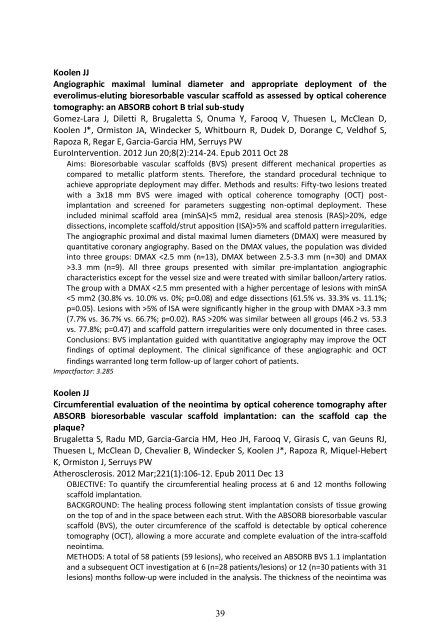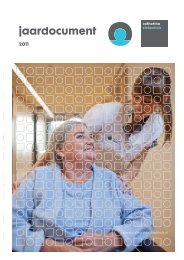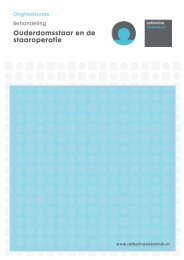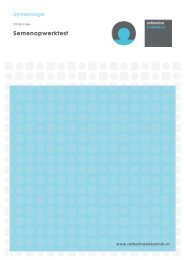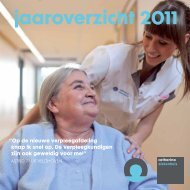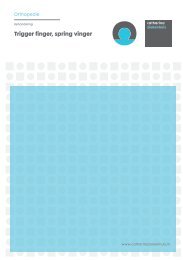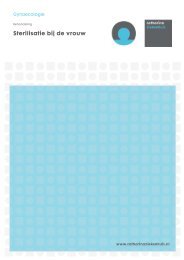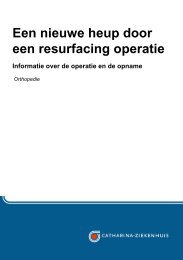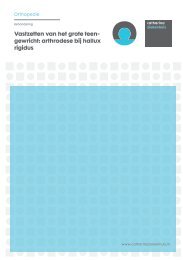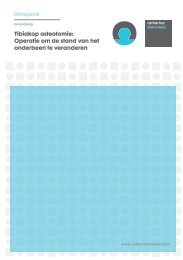Wetenschappelijk jaaroverzicht 2012 - Catharina Ziekenhuis
Wetenschappelijk jaaroverzicht 2012 - Catharina Ziekenhuis
Wetenschappelijk jaaroverzicht 2012 - Catharina Ziekenhuis
You also want an ePaper? Increase the reach of your titles
YUMPU automatically turns print PDFs into web optimized ePapers that Google loves.
Koolen JJ<br />
Angiographic maximal luminal diameter and appropriate deployment of the<br />
everolimus-eluting bioresorbable vascular scaffold as assessed by optical coherence<br />
tomography: an ABSORB cohort B trial sub-study<br />
Gomez-Lara J, Diletti R, Brugaletta S, Onuma Y, Farooq V, Thuesen L, McClean D,<br />
Koolen J*, Ormiston JA, Windecker S, Whitbourn R, Dudek D, Dorange C, Veldhof S,<br />
Rapoza R, Regar E, Garcia-Garcia HM, Serruys PW<br />
EuroIntervention. <strong>2012</strong> Jun 20;8(2):214-24. Epub 2011 Oct 28<br />
Aims: Bioresorbable vascular scaffolds (BVS) present different mechanical properties as<br />
compared to metallic platform stents. Therefore, the standard procedural technique to<br />
achieve appropriate deployment may differ. Methods and results: Fifty-two lesions treated<br />
with a 3x18 mm BVS were imaged with optical coherence tomography (OCT) postimplantation<br />
and screened for parameters suggesting non-optimal deployment. These<br />
included minimal scaffold area (minSA)20%, edge<br />
dissections, incomplete scaffold/strut apposition (ISA)>5% and scaffold pattern irregularities.<br />
The angiographic proximal and distal maximal lumen diameters (DMAX) were measured by<br />
quantitative coronary angiography. Based on the DMAX values, the population was divided<br />
into three groups: DMAX 3.3 mm (n=9). All three groups presented with similar pre-implantation angiographic<br />
characteristics except for the vessel size and were treated with similar balloon/artery ratios.<br />
The group with a DMAX 3.3 mm<br />
(7.7% vs. 36.7% vs. 66.7%; p=0.02). RAS >20% was similar between all groups (46.2 vs. 53.3<br />
vs. 77.8%; p=0.47) and scaffold pattern irregularities were only documented in three cases.<br />
Conclusions: BVS implantation guided with quantitative angiography may improve the OCT<br />
findings of optimal deployment. The clinical significance of these angiographic and OCT<br />
findings warranted long term follow-up of larger cohort of patients.<br />
Impactfactor: 3.285<br />
Koolen JJ<br />
Circumferential evaluation of the neointima by optical coherence tomography after<br />
ABSORB bioresorbable vascular scaffold implantation: can the scaffold cap the<br />
plaque?<br />
Brugaletta S, Radu MD, Garcia-Garcia HM, Heo JH, Farooq V, Girasis C, van Geuns RJ,<br />
Thuesen L, McClean D, Chevalier B, Windecker S, Koolen J*, Rapoza R, Miquel-Hebert<br />
K, Ormiston J, Serruys PW<br />
Atherosclerosis. <strong>2012</strong> Mar;221(1):106-12. Epub 2011 Dec 13<br />
OBJECTIVE: To quantify the circumferential healing process at 6 and 12 months following<br />
scaffold implantation.<br />
BACKGROUND: The healing process following stent implantation consists of tissue growing<br />
on the top of and in the space between each strut. With the ABSORB bioresorbable vascular<br />
scaffold (BVS), the outer circumference of the scaffold is detectable by optical coherence<br />
tomography (OCT), allowing a more accurate and complete evaluation of the intra-scaffold<br />
neointima.<br />
METHODS: A total of 58 patients (59 lesions), who received an ABSORB BVS 1.1 implantation<br />
and a subsequent OCT investigation at 6 (n=28 patients/lesions) or 12 (n=30 patients with 31<br />
lesions) months follow-up were included in the analysis. The thickness of the neointima was<br />
39


